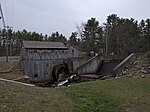Chester College of New England
Chester College of New England was a bachelor's degree-granting college that provided a foundation in the liberal arts and the fine arts, complemented by majors in the professional arts. It opened in 1965 as White Pines College and closed at the end of the 2011-2012 academic year for financial reasons. Located in Chester, New Hampshire, the college offered degree programs in creative writing, professional writing, photography and media arts, graphic design, computer science, fine arts, communication arts and interdisciplinary arts. Chester College also offered minor programs in creative writing, illustration, photojournalism, and writing. The college featured a student-to-faculty ratio of 10:1, artist-in-residence programs, and a program of guest lectures, exhibitions, art and photography exhibits, internships, and relationships with professional associations. In April 2012 the college disclosed an operating deficit. Despite fundraising efforts, in May 2012, the college's board of trustees announced that they had voted to close the college.
Excerpt from the Wikipedia article Chester College of New England (License: CC BY-SA 3.0, Authors).Chester College of New England
Chester Street,
Geographical coordinates (GPS) Address Nearby Places Show on map
Geographical coordinates (GPS)
| Latitude | Longitude |
|---|---|
| N 42.959444444444 ° | E -71.259722222222 ° |
Address
Chester Street 40
03036
New Hampshire, United States
Open on Google Maps









